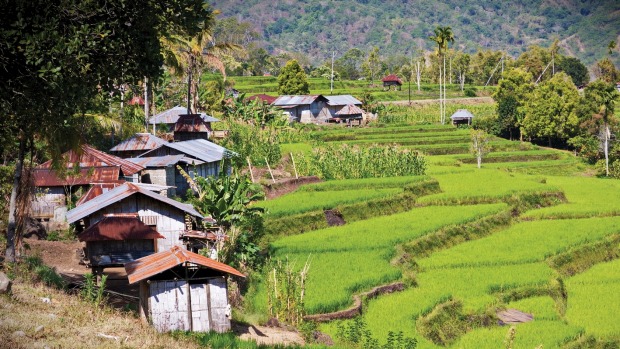
When the ship assumes its first drifting position of the journey, a line of people collectively forms the moment embarkation is announced. In a light swell, we step off the stern into zodiacs and are deposited on a remote island to swim in a brackish lake of jellyfish and, later, out to an ocean reef that drops away dramatically at a wall of bright coral patrolled by tropical fish and lone turtles.
Despite the matching orange life vests and string-bagged snorkelling gear, each person is on an individual journey. For some, today is exciting but relatively effortless while others are pushing themselves – either psychologically or physically or both – to be immersed in the sort of place they never believed they'd get to, especially at this shade of grey.
During our 17-day small ship expedition-style cruise through South East Asia, the associated subjects of travel and aging do get raised and kicked around more than once. Usually during the second or third glass of wine or course of dinner. Many people tell me that over time they've become increasingly protective of their personal safety, like to be guided when in foreign countries, have the odd health issue and feel better knowing there's a doctor nearby, and prefer creature comforts overnight. For most, a comfortable bed, ensuite and hot shower are deal breakers.
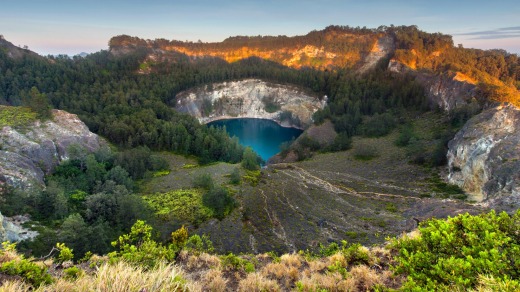
I'm not quite there myself – three of us in our forties cruising for work-related purposes are soon referred to by the other 100 or so passengers as "the kids". But I get it having witnessed my mother go through this process over the last decade: pull up her last tent peg, farewell multi-day cabin-based pack hikes, kiss winter campervanning goodbye. Though mum feels no regret because her adventures aren't over – she just travels in more comfort now to far-flung destinations that rival my own.
MS Caledonian Sky is full of similarly seasoned and destination-fascinated travellers who have chosen this particular cruise because, as they say themselves, "you can get places you wouldn't otherwise be able to go" and "you'd never get to these locations unless you were a backpacker". Which is what this expedition version of cruising seems to be all about: offering access to remote destinations and elements of adventure many other cruises don't, but with the cocktail-clinking cotton wool comforts of luxury travel on board.
At the initial debrief, expedition leader Jane Wilson tells us that after a few days in the Philippines and Malaysian Borneo we'll be on "an adventure to lots of wild and woolly parts of Indonesia that most people don't get to go to". And, indeed, every city, island, town, marketplace, village, beach, coral reef and lake on the itinerary are brand new for most passengers including me.
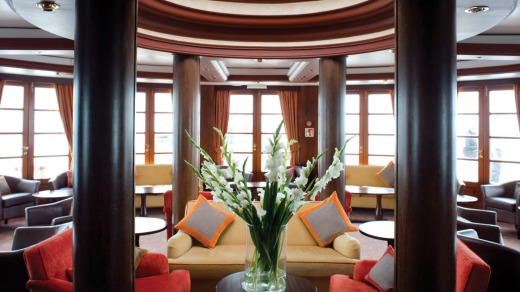
On a map, if you can imagine the islands of Malaysia and the Philippines are a single central sail of a boat headed east, with New Guinea as the stern and Sumatra its elaborate up-turned bow, we embark on the journey near the top of the mast in Manila. From there we slide slowly down the sail and hit the deck then travel in an easterly direction along the porthole-like islands of Indonesia to finish in the West Timorese city of Kupang. This Seven Seas Odyssey itinerary also runs in the reverse direction.
There's flexibility in the itinerary of this small ship expedition cruise and Wilson tells me she likes "guests to feel that they're all part of the adventure". When a couple of ports are cut from the original itinerary due to minor safety concerns, Wilson keeps everyone in the loop with alternatives: "this afternoon we're adding an island" and, on another day, "Captain and I have added a couple more snorkel spots".
Wilson is part of an expert expedition crew made up of international zodiac driving naturalists and ecologists – most with Antarctic experience – as well as two guests speakers: an archaeologist, and an ornithologist and conservationist who never twitches but calls it "birding".
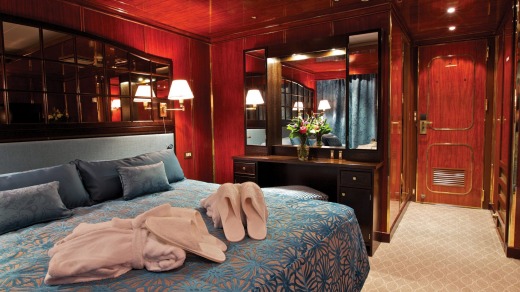
The crew totals about 75 people and Wilson tells me "it's rare there's a problem we can't fix".
Debriefings and presentations by the expedition crew are held between shore excursions. They range from in-depth lectures on the Great Malayo-Polynesian Migration to a more easily digestible chat about What Fish is That. School's always out by dinnertime, after which the band performs or runs a trivia night or hosts a sixties dance evening that has everyone shaking it up on the panorama deck.
Like any trip, it can take time to settle in. For the first four days the zodiacs hang on the back of the ship like inflated expectations. So although we're doing really interesting stuff – swimming in a limestone-lined lake, being paddled into underground caves, seeing macaques and sun bears and orang-utans, visiting fish markets where locals take photos of us we're such a novelty – to me it feels like a great cruise but not an expedition.
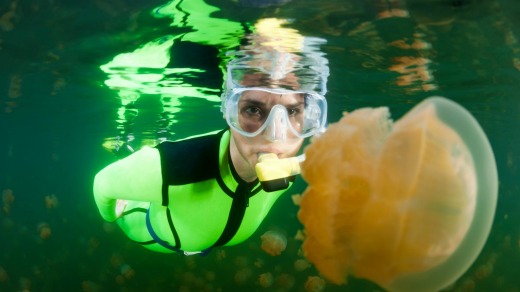
Then comes the day when the trip shifts into a different gear or we individually click into the groove of this type of journey.
For me, it's jumping into zodiacs off Palau to swim with jellyfish that have evolved to be stingless and then to snorkel with green turtles. For others it's the overnight stay in Tana Toraja with its cliff-hanging graves, deliciously creepy effigies, traditional houses with upside-down-boat-shaped roofs, and evening karaoke. Some people feel the shift walking the coconut plantation and sandy circumference of nature reserve Birah Birahan Island. For another it's the day we see dragons in Komodo National Park in the morning, swim and snorkel at Pink Beach in the afternoon and have cocktails on deck at Kaaba as a cloud of bats fly overhead in silhouette against a prawn-orange sunset.
At only 91 metres long, 15 metres wide and with a shallow draft, Caledonian Sky can go where the bigger ones can't. We sidle up to tiny docks like a car reversing into an impossibly small parking space, slip between turquoise-ringed coral atolls and get close enough to remote seaside villages to zodiac onto shore in minutes.
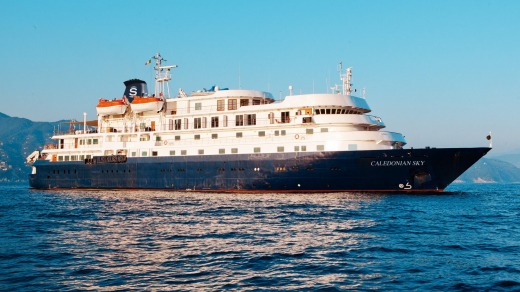
It feels we're experiencing a more original or authentic use of this sized ship: to explore, push the limits, discover new peoples, religions, architecture, food, lifestyles.
The company brochures suggests "a good level of fitness is needed to participate in this expedition cruise" and there's a range of interpretations on board: someone balks at walking 150 steps up to Kayangan Lake on day two while a woman who plays tennis daily back home doesn't feel she's really stretched her legs until the uphill gravel path and several hundred steps to the coloured crater lakes on Mount Kelimutu.
Though relative fitness is a tough one to gauge, and of course age is never a reliable indicator of ability – there are 70-somethings on board who are more physically fit than some 50-somethings on board. Yet everyone puts a hand up for snorkelling gear.
On these expedition cruises "most people are taken out of their comfort zone and we are very happy about that," Wilson says to me over a meal one evening, "and it's always amazing what people are capable of".
One guest tells me she prepared for the cruise by taking Pilates classes to improve her balance for walking gangplanks, stairs and uneven ground. The group, as a whole, become noticeably fitter and more confident as the trip goes on. Pretty soon nobody questions walking those stairs, or travelling on winding roads in decoratively spray-painted public minibuses with Eminem posters inside and the doors permanently open, or landing on a beach in a zodiac hauled through the waves by burley Indonesian whalers.
Perhaps because, back on board, comfort and consistency are guaranteed: a welcome back drink in a champagne flute, afternoon tea in an air-conditioned lounge, a hot shower and a quiet private space for a nap.
My standard suite is far more a plush hotel room than a cabin, with a freestanding queen-sized bed, dark glossy panelling, curtains to the floor over a huge window and a large bathroom with a bath. There's no room service, but there is turndown every night and my cabin attendant, Eric, puts a chocolate on my pillow and lays my pyjamas out in the shape of my body though with an unnaturally small waistline.
Yet some passengers aren't quite ready to admit how much they appreciate the comfort. "I wouldn't mind if it was less luxurious," says a woman, whose past adventures can be read in the lines of her face and light in her eyes, right before she stops the head waiter to ask if they have pinot gris.
Every person is different and there are plenty of golden oldie hard-core fully self-sufficient travellers out there. Deep down I hope to be one of them, travelling independently until I drop dead on a mountain trail and petrify in the wild weather like an old tree, but even deeper down is the niggling suspicion that I'm human and will follow in my mother's footsteps.
What I do know is that lust for travel doesn't necessarily go away as you get older and, for many, the desire can intensify the more you do it. Expedition cruises like this, finances willing, allow an adventurous spirit to keep on wandering even when the moving parts start to slow down or seize up.
MORE INFORMATION
aptouring.com.au
CRUISING THERE
APT is an 88-year-old family-owned business and these days sails most of the world's seas and many of its rivers. For these expedition-style trips in Asia, Northern Europe and the Kimberley the company owns and operates three small ships: MS Caledonian Sky, MS Island Sky and MS Hebridean Sky. Fares for the Seven Seas Odyssey, which will be called 17-day South East Asia Adventure in 2016, are from $11,995 per person, twin share. APT has an all-inclusive pricing policy with fares covering shore excursions, all meals, all beverages (apart from the most premium wines and spirits), gratuities, port charges and transfers. These expedition-style trips and ships are, however, not equipped to accommodate passengers in wheelchairs. Phone 1300 196 420; see aptouring.com.au.
FIVE WAYS TO BE A BETTER EXPEDITION CRUISE TRAVELLER
1 If you want to make donations along the way, give pens and books rather than chocolates and toys.
2 Share the love when purchasing local handicrafts and buy from a variety of sellers at different ports.
3 Reduce plastic waste by drinking the tap water on board and carrying a reusable bottle on shore.
4 For a richer travel experience, learn some local lingo and try it out whenever you land.
5 Help keep the places you're visiting healthier by using hand sanitiser as you head off on shore excursions.